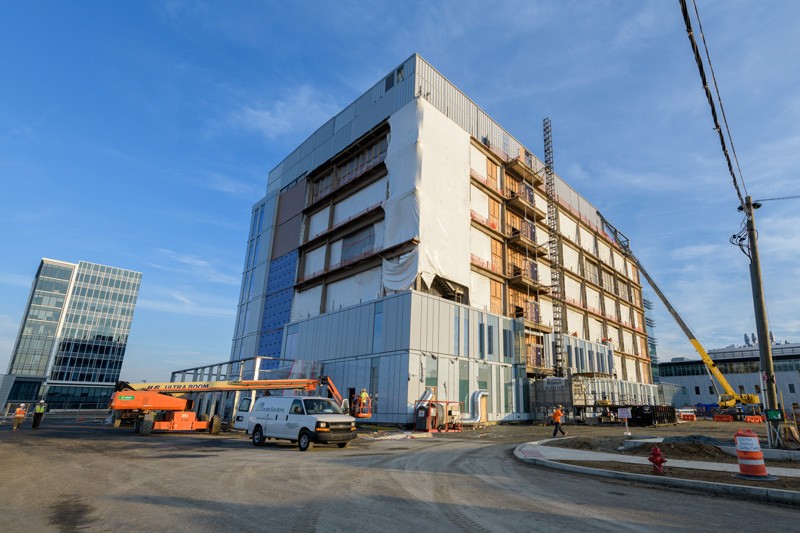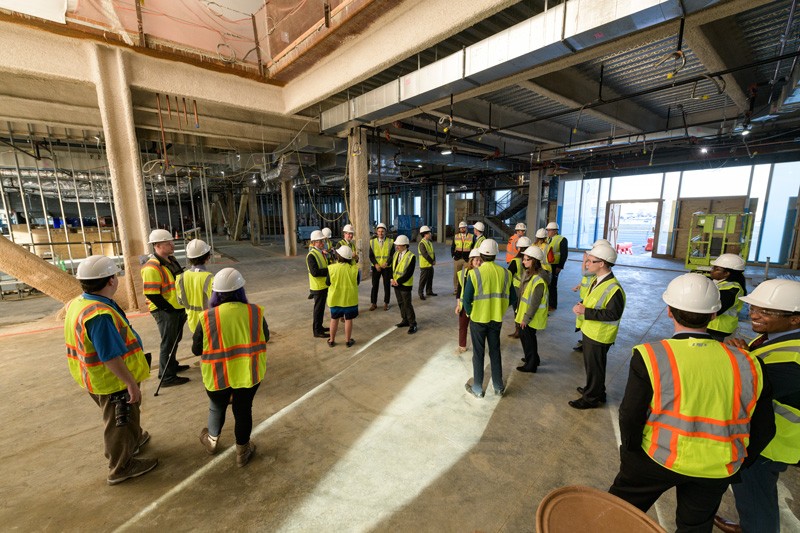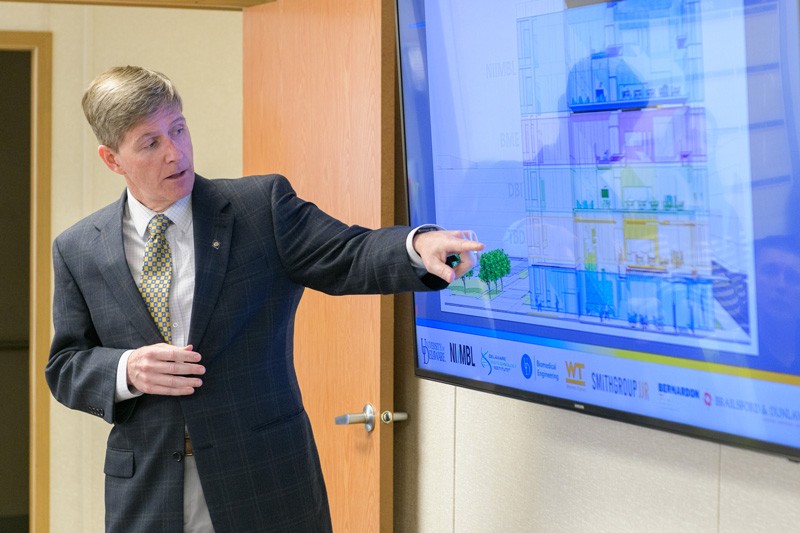Part of UD’s STAR Campus, the facility will be a center for research on producing complex medication
Sporting white hard hats, bright safety vests and protective goggles, Delaware Gov. John Carney and a small group of officials visited the construction site of the University of Delaware’s Ammon Pinizzotto Biopharmaceutical Innovation Center on Tuesday, Feb. 5. The tour offered a glimpse into the future of growth and innovation at the University.
“Part of my interest is in seeing where the state’s investments are going both in terms of the collaboration, which we match with NIH and NSF money, as well as our higher ed development fund,” Carney said, referring to the federal National Institutes of Health and National Science Foundation, along with the state’s Higher Education Economic Development Investment Fund. “I want to fund that again and add more money than I proposed last time. I think that opportunity might present itself this year, so I’m here seeing what it translates into.”

Construction began in October 2017 on the Ammon Pinizzotto Biopharmaceutical Innovation Center Center on UD’s STAR Campus.
Construction on the biopharmaceutical innovation building began after a ceremonial groundbreaking in October 2017. Part of UD’s Science, Technology and Advanced Research (STAR) Campus, the six-story 200,000-square-foot project will bring together research by more than 150 universities, private companies and nonprofits from around the United States. It will also serve as the headquarters for the National Institute for Innovation in Manufacturing Biopharmaceuticals (NIIMBL).
Charles G. Riordan, vice president for research, scholarship and innovation at UD, kicked off the tour with an overview of the building plans. He emphasized the potential for the building to foster work that will impact the healthcare market in the United States and beyond.
“How do you innovate manufacturing of these large molecule drugs to help get them in the market and get them to patients?” Riordan asked rhetorically. “The University is very interested in leveraging all of that manufacturing innovation to continue to grow our basic discovery sciences in that space.”
Biopharmaceuticals are sometimes called biologics. According to the U.S. Food and Drug Administration, “Biologics can be composed of sugars, proteins or nucleic acids or complex combinations of these substances, or may be living entities such as cells and tissues.” Those complex combinations can produce larger molecules than found in chemically-synthesized medications. But the manufacturing of such medicine is more difficult and expensive, and NIIMBL was founded with the hope that collective research efforts could produce high-quality biologics at lower costs.
Biologics are used to create products such as some vaccines, cancer drugs and antibodies — all potential life-saving treatments — so the payoff to society can be great. The new building will bring some of that research to UD’s STAR Campus.

The Ammon Pinizzotto Biopharmaceutical Innovation Center on UD’s STAR Campus will also serve as the headquarters for the National Institute for Innovation in Manufacturing Biopharmaceuticals (NIIMBL).
Kelvin Lee, director of NIIMBL and Gore Professor of Chemical Engineering at UD, said the new facility will bring researchers from outside Delaware to campus and help educate future workers in pharmaceutical manufacturing and research.
“This space is going to be unique,” Lee said.
Mike Palotas, project manager for Whiting-Turner, the main construction contractor, led the group through the first three floors of the building. He pointed out special considerations in the design to accommodate state-of-the-art labs, offices and community space. One example was the patterned design built into the floor-to-ceiling windows to deflect direct sunlight. The first phase of construction is nearly complete, and workers will soon begin to put up drywall, Palotas said.
Throughout the tour, Carney asked various logistical questions. He also spoke with a few graduate students who will likely utilize the space, about their research and the impact of the new facility.
Upon completion, the building will provide benefits to both the University and the state, said Jeff Garland, vice president and University secretary.
“We’re excited about it,” he said. “About the emphasis on our economic development because that underpins what we’ve been saying all along — a big research university provides a greater economic earning for our state — and I think that’s a good thing.”

Charles G. Riordan, vice president for research, scholarship and innovation at UD, describes the plans for the Ammon Pinizzotto Biopharmaceutical Innovation Center, which is under construction on UD’s Science, Technology and Advanced Research (STAR) Campus. Delaware Gov. John Carney visited the site on Tuesday, Feb. 5.

